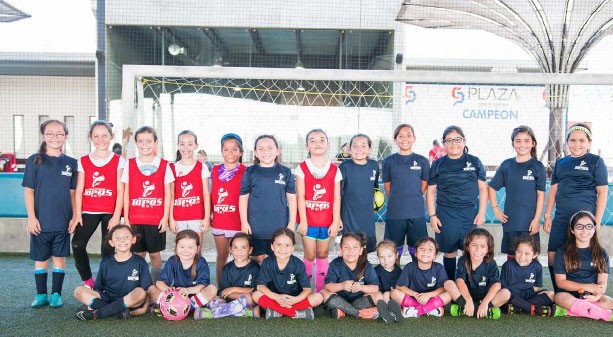
New soccer program at Plaza helps girls grow their skills.
Did you know that the first national women’s soccer league in the U.S. wasn’t established until 1995, or that women’s soccer wasn’t an Olympic event until 1996?
We have come quite a way since then; the United States is now regard-ed as one of the top countries in the world for women’s soccer. The U.S. team won the 2015 FIFA Women’s World Cup, and more women and girls are showing an interest in playing soccer competitively. However, much like the beginnings of organized women’s soccer in the United States, opportunities for fe-male soccer players in the Rio Grande Valley are lagging behind what is typically offered for male players.
“There are individual teams for girls, and we see the great work and effort parents and coaches are doing as individuals,” says Alma Caso, CEO of Plaza Sports Center. “But it’s hard for girls to find teams of the same levels, and we want to help them play competitively.” Whether a league or intramural team, the first step for any soccer player is finding a group to play with that is at a level that loosely matches their own and shares a similar goal. For players who want to go as far as possible with their athletic careers, it is vital that they keep pushing them-selves to get better at the sport by training the right way and playing against challenging opponents. It may be hard for girls seeking chal-lenging competitors to meet them on the field if they aren’t part of a league.
beginners and less-competitive female players also want to play with others of similar skill in a way that is not overwhelming. Currently, there ar-en’t as many girls’ classes and teams for beginners as you find for boys, so young girls are often not introduced to the sport until a much later age.
“Teaching young girls the technique they need to learn when they’re young matters,” says Coach Lindsay Vera, “ so when they get to play at high school, they are already are as good as they can possibly be.” (You can read more about the benefits of train-ing early in life on page 12.) Dedicat-ed players who are showing success on a high school team could develop their skills further and possibly be drafted for a college team, like Lind-say was, and later even a professional team, which she also experienced. Caso says there is a need in the Valley for dedicated attention to our female players. Some girls’ teams around the valley are a mix of casual and competitive players, which could be frustrating for players who have different skill levels and goals. Female players of all levels may find their potential stifled from a lack of dedicat-ed attention and focused competition. Plaza Sports Center wants to correct that by offering a dedicated girls’ league to help girls of all levels find a team to play on and open the door for competition among female teams. Bringing Coach Lindsay to Plaza was a first step to supporting girls in the Valley who have aspirations of playing soccer. With the U.S. women’s team playing so well, and a coach like herself close at hand, she thinks girls have many role models to look up to. “We have the best coaches and resources to train girls. It’s an awesome opportunity that Plaza is providing here with the Academy,” says coach Lindsay. Even if they don’t plan to play professionally, the sport is especially beneficial to girls for many rea-sons. Like the boys who play and train at Plaza, girl soccer players become dedicated and disciplined to accomplish their goals. In addition to the health benefits of exercise, sun, and fresh air, soccer helps girls build confidence in themselves and each other – both on and off the field. “When you’re out there on the field, everyone gets put in the spotlight,” says Lindsay. “Early on, you get used to being under pressure.” If you can handle the intensity of a soccer match, you can handle anything. Being on a team also allows girls to practice communication and forming bonds, which is vital in pre-teen and teenage years when bullying can be an issue. “Soccer forces girls to work together on the field despite their personalities off the field; they have to be friends while they’re playing to become a team. It helps them appreciate the differences in each other,” says Coach Lindsay. “They end up being friends with more types of people.” Soccer also becomes a social network that you take everywhere you go. More RGV girls are head-ing off to college on soccer scholarships every year, which is awesome and a testament to the growth of the local soccer scene. Lindsay shares that when she moved away for college (where she played on the university team), she felt less homesick because she automatically had a group of 30 friends – her new teammates. “When school starts, it’s much less overwhelming when you have some teammates in your classes to hang out with and study with,” says Lindsay. “It’s like a little family.”
